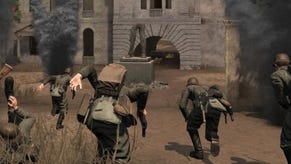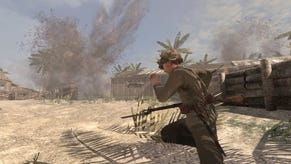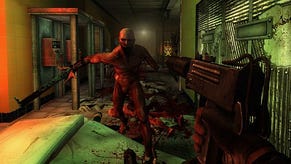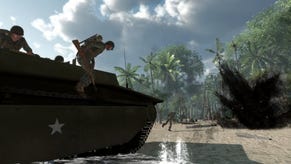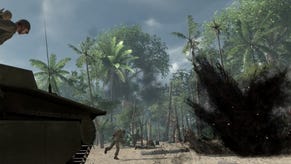Wot I Think: Red Orchestra 2
Tripwire detonated
Last week's launch of Red Orchestra 2: Heroes Of Stalingrad was a troubled one. With a seemingly overwhelming number of players reporting bugs and performance issues, it stumbled into commercial release still reeling from the flashbangs of development. Can Tripwire's brutal shooter sequel get past this quagmire of problems and snatch victory from the jaws of crashbugs? Here's Wot I Think.
There's little doubt that Tripwire mangled the normally-reliable workhorse of the Unreal engine into something more like a haywire donkey for the beta and launch of Red Orchestra 2. The bugs were many and the performance issues on less muscular PCs woeful. It's unacceptable when games turn up like this, and despite the near-certainty that Tripwire will patch and polish this game into a shining medallion of PC shooter achievement, I can't help feel disappointed that so many gamers had to suffer those experiences of exasperation and frustration not just during the vital testing phase of the beta, but also in the days beyond. It doesn't help when the game itself is so challenging, either. Any company that inflicts such pain on its players trades away lots of goodwill, of course, and Tripwire will have to earn that back. And they can do that by showing us what a magnificent donkey they've actually created.

What this broken metaphor is reaching for is that Red Orchestra 2 is a strong, sometimes thrilling game that carries some of the enormous weight of expectation placed on it. When it works, it's genuinely something special. It's a fierce game, focused on an intense and ambitious multiplayer game with vehicles and versatile infantry on maps that support up to 64 players. It is primarily multiplayer (although there is a bot driven campaign which I will mention later) and it is extremely demanding in a number of ways. The level of skill and concentration it begs is old fashioned, but its also refreshingly honest about what a lot of gamers actually want from their FPS games: a nerve-fraying experience that insists you learn how to play, rather than simply teaching you how to get to the next level.
The most crucially important aspect of Red Orchestra 2 is what it inherited from the previous games - mods that were equally unforgiving in their determination to paint WW2 realism onto less complex bones. In terms of the cover and gunplay model, and how it has built on what went before, this is a minor masterpiece, and it is mechanically fascinating. There's not much in the world of FPS games that matches up to this, I feel, and that's clear from the first tortuous rifle exchange across an ashen field of battle.
The use of cover allows you to hug close to it, pop over it, lean around it, and generally make use of what litters the combat environment in a way that most other games only hint at - I am thinking here of the likes of Crysis 2, with its cover-surfing attachment system. What we have here in RO2 is not exactly a simulation, but it is nevertheless setting out to deliver a kind of fuller realism than FPS games generally wish to challenge their players with. You can crouch behind cover here or there, wherever something stands in the battlefield, and then pop up to takes shots, fire blind, mantle over the cover, go prone, sprint from crouching or prone, crawl on your belly, lean around corners... yes, the potential for adaptation and precision in movement here is on a par with (and personally I feel far slicker than) games like Arma 2. The way Red Orchestra 2 works in terms of rolling all this into a functional system is exciting and engaging to my FPS-warped brain. (I hope Stalker 2 and other forthcoming PC stalwarts manages to do something similar in the future.)

The gunplay too, is more intricate than we might be used to, with guns modelled close to how the might behave in the real world. Expect to use iron sights, and expect to have to adjust the calibration of these for distance. Lethality is enormously high, too, and if a sniper gets his crosshairs over you, that's it. I know that extreme likelihood of instant death makes these sorts of games off-putting for many players, but it's also precisely why I am getting a kick out of it. The personal reward of surviving, and then going further than that into killing, makes this far more dramatic than the more run-and-gun shooters I (and I suspect most of you lot) have been playing over the past few years. Seeing a comrade go down, knowing the sniper is on you, and then escaping - or even taking him out - is a brilliant videogame high.
That said, there are some bizarre aspects to it that I don't quite understand. It seems that the concessions to realism mean that the German equipment really is better than that carried by the Russian team... Which means it's deliberately unbalanced? I mean am assuming that's deliberate, and not some weird fluke of development, but it left me puzzled. This is still a game, after all. Realism need only go so far. Did we really need to go that far? I had a bit of a search for this issue on forums and so forth, expecting it to be some aspect of one of the "hardcore" game modes, but it genuinely seems to be a thing. Baffling.
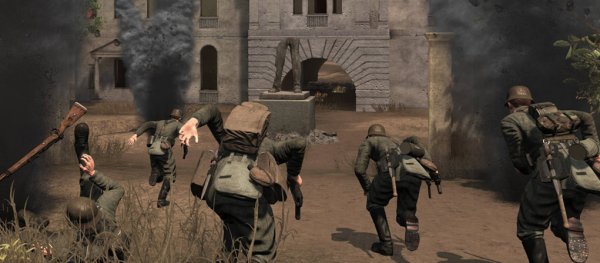
Anyway, yes, the general trend for accessibility in gaming is a good one, I think, because it made designers think about what they were making, and make it better. Better designs almost always mean comprehensible game systems, and that generally makes for more interesting games. But I think many designers eventually headed off in wrong directions with the idea, because being accessible doesn't mean that the game is simple, necessarily, but more that it teaches you how to play, and keeps you wanting to learn what it has to teach. There are a few games that are good at this, and there others which basically admit that they are terrible teachers, even though their lessons are vital and ultimately fascinating. RO2 is one of those terrible teachers, although it doesn't want to admit it. Red Orchestra's tutorial, which is essentially a bootcamp sequence which teaches a bit about bullet falloff, iron sites, going prone and all that malarky, then opens up into a bot-driven campaign, where you get to put some of this into practice. It's okay, I suppose - if you ignore the armed-but-stunned-clown AI - but not all that entertaining, and certainly not as entertaining as playing against real people. Which is where the game becomes inaccessible. Real people are tough to play against, but defeating them also matters.
Even in open matches of the less hardcore modes of the multi-player game you need to be fairly FPS-competent to compete. It demands that you learn things like the map layouts and personal spatial awareness very quickly indeed. The issue here is that despite being tough, Red Orchestra is, fortunately, equally compelling on numerous levels. Mechanically it feels superb to master. As I've already mentioned the FPS mechanics and weapon physics are sort of welcomingly realistic, without seeming simulatory, but also very flexible, and provide both dynamic possibilities for how a player approaches a situation, and the capacity to do more than just run behind the nearest wall when getting in and out of trouble. The weapons too offer more with their nod to realism: bullets smacking through thin cover is a terrifying thing to be on the wrong side of, but also fantastic to take advantage of.

The game does not, I think, look as good as it could do, with plenty of muddy textures and odd bits of level design. (In fact I found the maps to be generally disappointing, not simply in visuals but also in layout - some of them simply do favour one team, which makes sense, given history, but again it's something I an uncomfortable with.) I understand that the Eastern Front was a lot of flat Russian towns lying in ruins, but I just wanted a bit more imagination or unexpectedness than is on offer here. But the failings in vision for the art almost don't matter, because the overall atmosphere it delivers, in everything from the palette of the world to the intense and brilliantly orchestrated audio, creates an evocative experience. The physicality of it, too, is never in doubt, and the animations, the sound effects, and the general visual feedback from weapons and explosions give a splendid impression of close up war. There's a lot of detail here, especially in the way characters move, and it all makes a lot of sense. Ugly, perhaps, but it's ugly in the way that a brilliant actor can get away with not having a face for Hollywood. All the talent is there underneath. It moves in a way that might not be pretty, but is convincing and useful to the project at hand. And the project here is brutal manshootery.
I can still hear the screams.
CONCLUSIONWAFFE: Red Orchestra 2 is a bold, frightening, stumbling beast of a game. It is laden with mod heritage, some good some bad, making only a nod to newbies and sending frustrated bug-suffers to lay face down in the blood-streaked swamp of annoyance. Some people are already spitting out their own teeth in frustration at crash bugs and performance jitters, and will continue to do so at least until they're ironed out, and that's a shame. Those that can get away with smoother experiences, however, are feeling much happier. (I am one of those. My tech troubles have been limited to some jitters with the browser. and a single crash in the beta) Further, it's not going to worry Battlefield 3's visuals, or any other FPS's single-player for that matter, because despite the attempt to package the bot-play as single-player, that aspect can be all but jettisoned as an irrelevance. That's reflected in the price.
Red Orchestra 2 rides on its attempt to push classical FPS game modes towards a sort of limited realism, and it excels at that. Yes, despite all the quibbling I still can't help feeling that this is one of the most laudable games I've played this year. Get hold of it if you are even vaguely inclined towards more serious multiplayer combat, it's quite the game.


